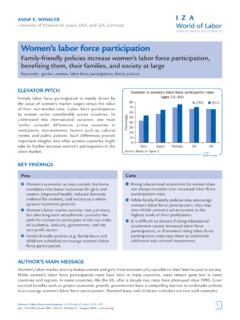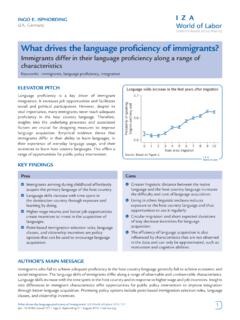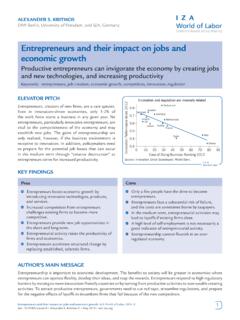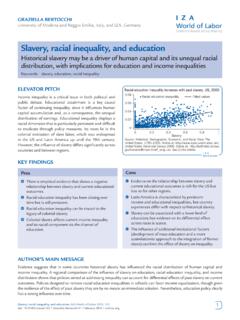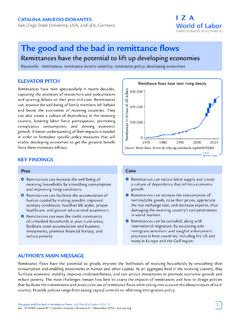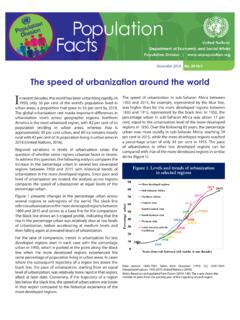Transcription of The brain drain from developing countries
1 Fr d ric docquierUniversit Catholique de Louvain, Belgium, and IZA, GermanyThe brain drain from developing countries . IZA World of Labor 2014: 31doi: | Fr d ric Docquier | May 2014 | Pros The income-maximizing level of a brain drain is usually positive in developing countries , meaning that some emigration of the more skilled is beneficial. A brain drain stimulates education, induces remittance flows, reduces international transaction costs, and generates benefits in source countries from both returnees and the diaspora abroad. Appropriate policy adjustments, which depend on the characteristics and policy objectives of the source country, can help to maximize the gains or minimize the costs of the brain PiTcHThe proportion of foreign-born people in rich countries has tripled since 1960, and the emigration of high-skilled people from poor countries has accelerated.
2 Many countries intensify their efforts to attract and retain foreign students, which increases the risk of brain drain in the sending countries . In poor countries , this transfer can change the skill structure of the labor force, cause labor shortages, and affect fiscal policy, but it can also generate remittances and other benefits from expatriates and returnees. Overall, it can be a boon or a curse for developing countries , depending on the country s characteristics and policy S MAiN MeSSAGeThe impact of the brain drain on a source country s welfare and development can be beneficial or harmful.
3 The evidence suggests that there are many more losers than winners among developing countries . Whether a country gains or loses depends on country-specific factors, such as the level and composition of migration, the country s level of development, and such characteristics as population size, language, and geographic location. Policymakers should gauge the costs and benefits of the brain drain in order to design appropriate policy The effective brain drain exceeds the income-maximizing level in the vast majority of developing countries , especially in sub-Saharan Africa, Central America, and small countries . A brain drain may cause fiscal losses. Above a certain level, brain drain reduces the stock of human capital and induces occupational brain drain from developing countriesThe brain drain produces many more losers than winners in developing countriesKeywords: migration, brain drain , development, growthKeY FiN diNGSS ource: [1].
4 9876543210 brain drain rates decrease with economic developmentWorldProportion of nationals living abroad (%)High-incomeUpper-middleLower-middleLo w-incomeLess educatedCollege graduatesIZA World of Labor | May 2014 | d ric docquier | The brain drain from developing countries MoTi VATioNThe term brain drain refers to the international transfer of human capital resources, and it applies mainly to the migration of highly educated individuals from developing to developed countries . In lay usage, the term is generally used in a narrower sense and relates more specifically to the migration of engineers, physicians, scientists, and other very high-skilled professionals with university training, often between developed a concern for rich countries , the brain drain has long been viewed as a serious constraint on the development of poor countries .
5 Comparative data reveal that by 2000 there were 20 million high-skilled immigrants (foreign-born workers with higher education) living in member countries of the Organisation for Economic Co-operation and Development (OECD), a 70% increase in ten years. Two-thirds of these high-skilled immigrants came from developing and transition ScuSS ioN oF ProS ANd coNSKey trends in high-skilled migrationAccording to the United Nations Global Migration Database, the number of international migrants increased from 75 million in 1960 to 214 million in 2010. This about parallels the growth in the world population, so the world migration rate increased only slightly in relative terms, from to of the world population.
6 The major part of this change is artificial and due to the break-up of the former Soviet Union, when what was once the internal movement of workers became reclassified as international migration after 1990. Overall, the share of international migrants in the world population has been stable for the last 50 the picture changes when the focus is narrowed to migration to developed countries . The proportion of international migrants residing in high-income countries relative to the total in all possible destinations increased from 43% to 60% between 1960 and 2010. As measured by the proportion of the foreign-born in the total population of high-income countries , the average immigration rate to these countries has tripled since 1960 and doubled since 1985.
7 The increase has followed the same trajectory as the ratio of trade to gross domestic product (GDP) (see Figure 1).More of these migrants are coming from non-OECD countries . Indeed, a database of global bilateral migration published in 2011 reveals that as of 2000, migration between developing countries still dominated the global migrant stock: at million people, migration between developing countries constituted about 45% of all international migration (see Figure 2) [2]. Next came migration from developing to developed countries (55 million, 34% of all migrants) and then migration between developed countries (28 million, 17%).
8 But the growth in the number of migrants was driven largely by emigration from developing countries to developed countries , which increased from ten million to 55 million between 1960 and 2000, faster than rates of high-skilled workers exceed those of low-skill workers in virtually all countries (see Figure 3) [1]. The skill bias in emigration rates is particularly pronounced in low-income countries (see What drives the brain drain , and how can we quantify it?). The largest brain drain rates are observed in small, poor countries in the tropics, and they rise over the 1990s. The worst-affected countries see more than 80% of their brains emigrating abroad, such as for Haiti, Jamaica, and several small states with fewer than IZA World of Labor | May 2014 | d ric docquier | The brain drain from developing countries one million workers.
9 About 20 other countries are losing between one-third and one-half of their college graduates. Most are in sub-Saharan Africa (such as Liberia, Sierra Leone, and Somalia) or Asia (such as Afghanistan and Cambodia). A few are small, high-income countries (such as Hong Kong and Ireland).expected adverse and beneficial effects of skilled migrationThe brain drain has long been viewed as detrimental to the growth potential of the home country and the welfare of those left behind. It is usually expected to be even more harmful for the least developed countries because, as explained above, with increasing development, positive selection in emigration and brain drain rates drives the brain drain , and how can we quantify it?
10 Poverty and a lack of economic growth, going hand in hand with discrimination, political repression, and a lack of freedom, motivate people to flee their country. The brain drain can be decomposed into two multiplicative components: the average emigration rate (the mean of all skill groups) and an index of positive selection in emigration (the proportion of college graduates in the total number emigrating divided by the proportion of college graduates among natives).The average emigration rate is an indicator of openness to migration; it depends on country size, geographic and cultural characteristics, and (to a lesser extent) development. The largest emigration rates are observed in middle-income countries , where incentives to leave are important and liquidity constraints (on travel) are not severe.

